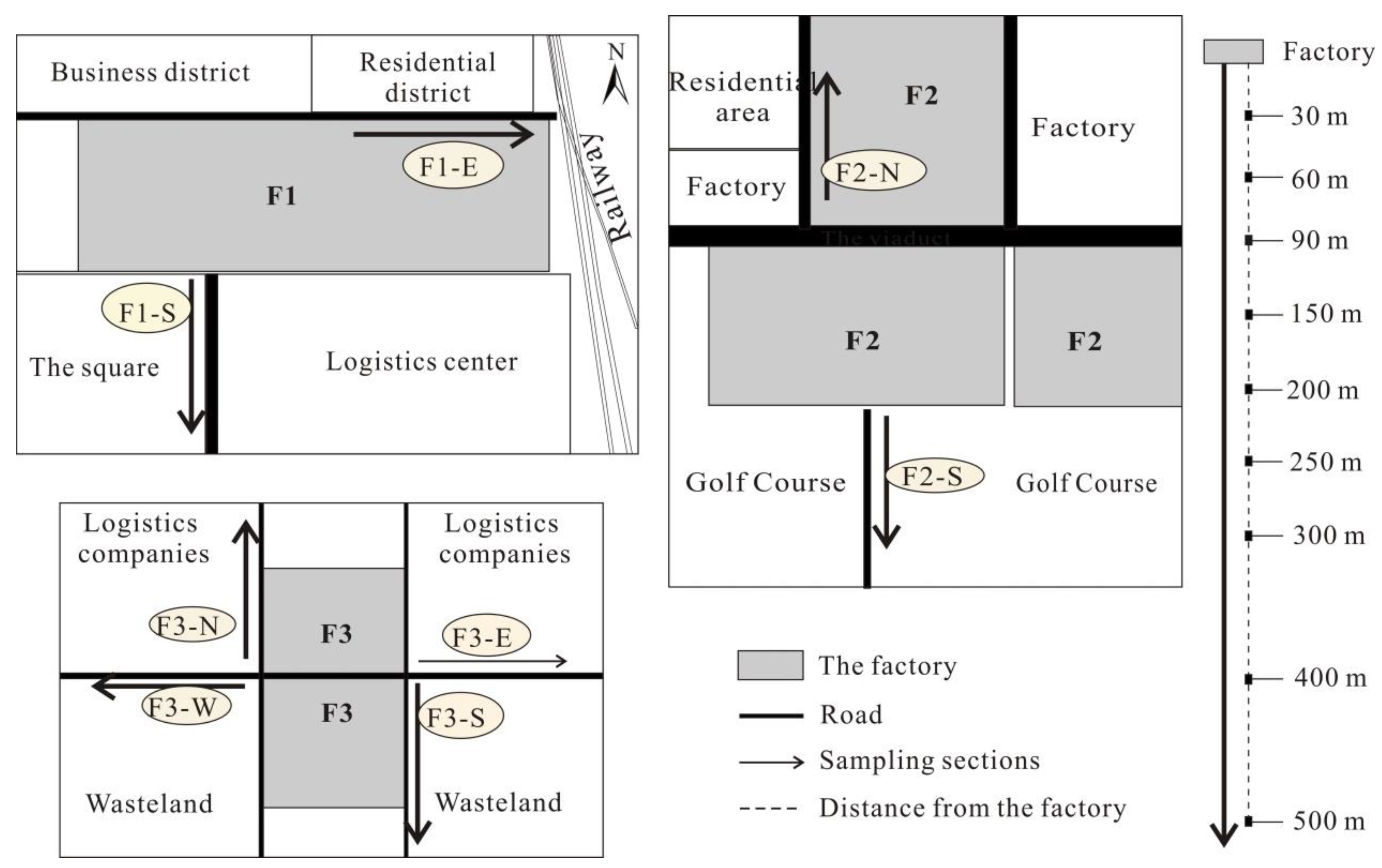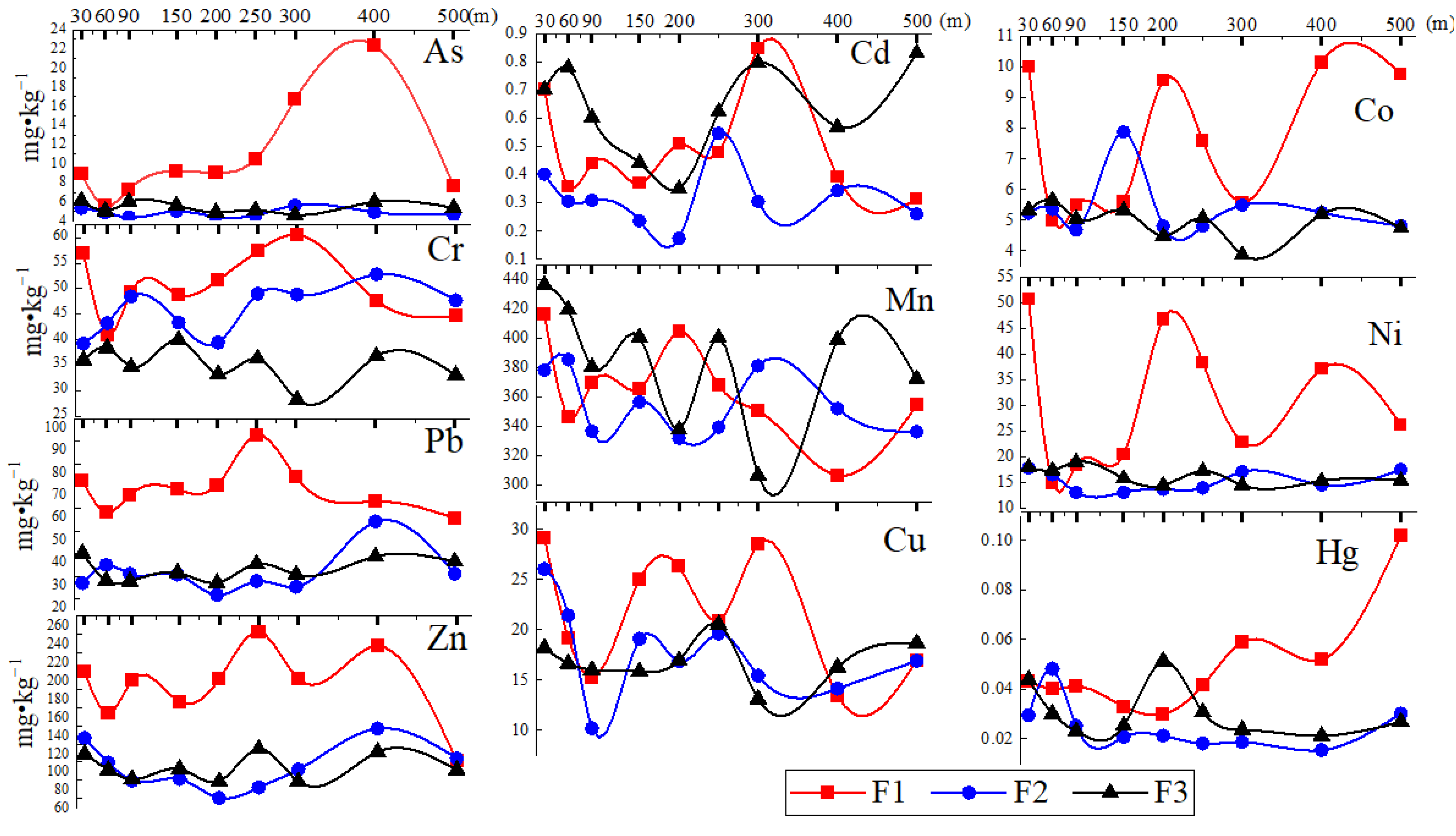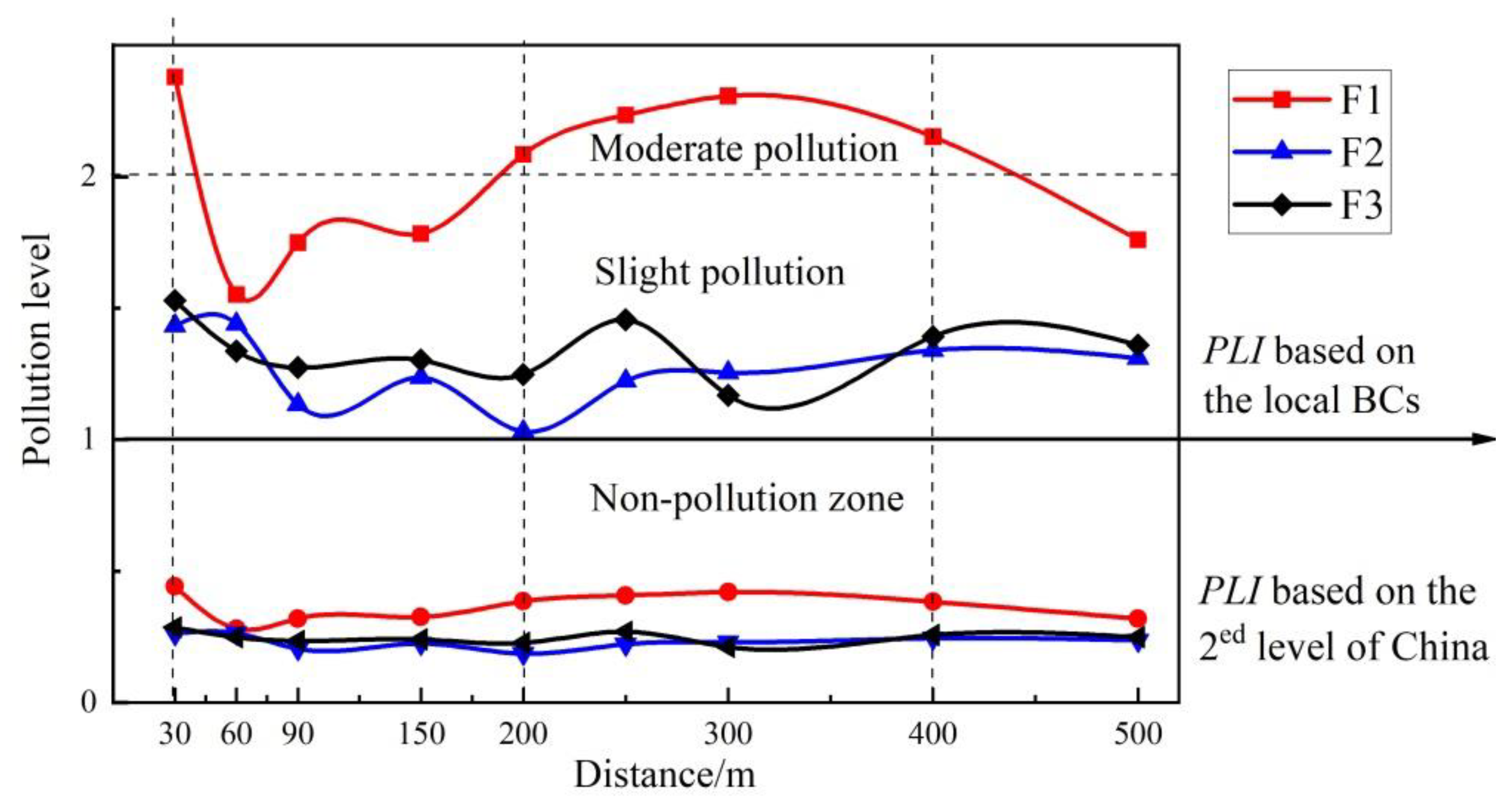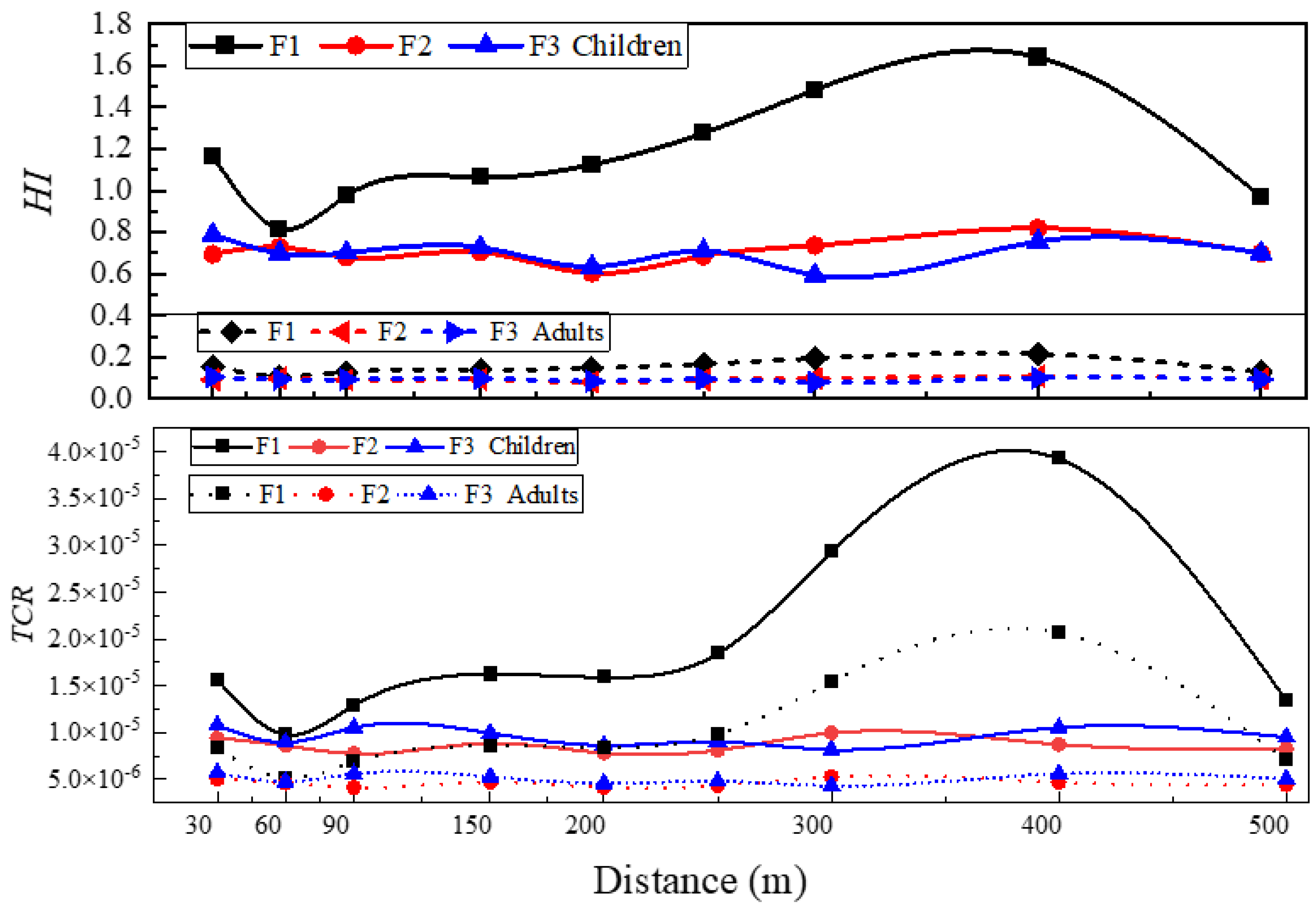Variation in Road Dust Heavy Metal Concentration, Pollution, and Health Risk with Distance from the Factories in a City–Industry Integration Area, China
Abstract
1. Introduction
2. Materials and Methods
2.1. Study Area
2.2. Sample Collection
2.3. Sample Preparation and Heavy Metal Analysis
2.4. Quality Assurance and Quality Control
2.5. Heavy Metal Pollution Assessment
2.6. Health Risk Assessment Model
3. Results
3.1. Characteristics of Dust Heavy Metal Concentrations
3.2. Spatial Distribution of Dust Heavy Metal Concentrations with Distance from the Three Factories
3.3. Heavy Metal Pollution Assessment
3.4. Human Health Risk Assessment
4. Discussion
4.1. Effects of Factory Type on Dust Heavy Metal Concentrations
4.2. Factors Affecting the Spatial Distribution of Dust Heavy Metal Concentrations
4.3. Effects of Various Heavy Metal Concentrations on Spatial Distribution Characteristics for Pollution and Health Risk
5. Conclusions
Supplementary Materials
Author Contributions
Funding
Institutional Review Board Statement
Informed Consent Statement
Data Availability Statement
Acknowledgments
Conflicts of Interest
References
- Wei, X.; Gao, B.; Wang, P.; Zhou, H.; Lu, J. Pollution characteristics and health risk assessment of heavy metals in street dusts from different functional areas in Beijing, China. Ecotoxiol. Environ. Safe 2015, 112, 186–192. [Google Scholar] [CrossRef] [PubMed]
- Zhang, Y.; Ji, X.; Ku, T.; Li, G.; Sang, N. Heavy metals bound to fine particulate matter from northern China induce season-dependent health risks: A study based on myocardial toxicity. Environ. Pollut. 2016, 216, 380–390. [Google Scholar] [CrossRef] [PubMed]
- Liu, A.; Hong, N.; Zhu, P.; Guan, Y. Characterizing petroleum hydrocarbons deposited on road surfaces in urban environments. Sci. Total Environ. 2019, 653, 589–596. [Google Scholar] [CrossRef] [PubMed]
- Zhu, X.; Yu, W.; Li, F.; Liu, C.; Tian, R. Spatio-temporal distribution and source identification of heavy metals in particle size fractions of road dust from a typical industrial district. Sci. Total Environ. 2021, 780, 146357. [Google Scholar] [CrossRef]
- Zhou, L.; Liu, G.J.; Shen, M.C.; Liu, Y. Potential ecological and health risks of heavy metals for indoor and corresponding outdoor dust in Hefei, Central China. Chemosphere 2022, 302, 134864. [Google Scholar] [CrossRef]
- Huang, C.S.; Zhang, L.J.; Meng, J.L.; Yu, Y.J.; Qi, J.Y.; Shen, P.; Li, X.; Ding, P.; Chen, M.B.; Hu, G.C. Characteristics, source apportionment and health risk assessment of heavy metals in urban road dust of the Pearl River Delta, South China. Ecotox. Environ. Safe 2022, 236, 113490. [Google Scholar] [CrossRef]
- US EPA. Guidelines for Exposure Assessment; U.S. Environmental Protection Agency: Washington, DC, USA, 1989.
- US EPA. Supplemental Guidance for Developing Soil Screening Levels for Superfund Sites; OSWER9355; Office of Solid Waste and Emergency Response: Washington, DC, USA, 2002; pp. 4–24.
- Nargis, A.; Habib, A.; Islam, M.N.; Chen, K.; Sarker, M.S.L.; Al-Razee, A.N.N.; Liu, W.B.; Liu, G.R.; Cai, M.G. Source identification, contamination status and health risk assessment of heavy metals from road dusts in Dhaka, Bangladesh. J. Environ. Sci. 2022, 121, 159–174. [Google Scholar] [CrossRef]
- Suvetha, M.; Charles, E.P.; Vinothkannan, A.; Rajaram, R.; Paray, B.A.; Ali, S. Are we at risk because of road dust? An ecological and health risk assessment of heavy metals in a rapid growing city in South India. Environ. Adv. 2022, 7, 100165. [Google Scholar] [CrossRef]
- Gan, L.; Shi, H.; Hu, Y.; Lev, B.; Lan, H. Coupling coordination degree for urbanization city-industry integration level: Sichuan case. Sustain. Cities Soc. 2020, 58, 102136. [Google Scholar] [CrossRef]
- Shen, M.; Ren, M.; Wang, Y.; Shen, F.; Cao, Z. Identifying dust as the dominant source of exposure to heavy metals for residents around battery factories in the Battery Industrial Capital of China. Sci. Total Environ. 2020, 765, 144375. [Google Scholar] [CrossRef]
- Qin, Y.F.; Liu, Y.Q.; Wang, J.B.; Lu, Y.; Xu, Z.M. Emission of PAHs, PCBs, PBDEs and heavy metals in air, water and soil around a waste plastic recycling factory in an industrial park, Eastern China. Chemosphere 2022, 294, 133734. [Google Scholar] [CrossRef]
- Shahab, A.; Zhang, H.; Ullah, H.; Rashid, A.; Xiao, H. Pollution characteristics and toxicity of potentially toxic elements in road dust of a tourist city, Guilin, China: Ecological and health risk assessment. Environ. Pollut. 2020, 266, 115419. [Google Scholar] [CrossRef] [PubMed]
- Yesilkanat, C.M.; Kobya, Y. Spatial characteristics of ecological and health risks of toxic heavy metal Pollution from road dust in the Black Sea coast of Turkey. Geoderma Reg. 2021, 25, 00388. [Google Scholar] [CrossRef]
- Yuan, G.L.; Sun, T.H.; Han, P.; Li, J. Environmental geochemical mapping and multivariate geostatistical analysis of heavy metals in topsoils of a closed steel smelter: Capital Iron & Steel Factory, Beijing, China. J. Geochem. Explor. 2013, 130, 15–21. [Google Scholar]
- Chen, Y.N.; Ma, J.H.; Miao, C.H.; Ruan, X.L. Occurrence and environmental impact of industrial agglomeration on regional soil heavy metalloid accumulation: A case study of the Zhengzhou Economic and Technological Development Zone (ZETZ), China. J. Clean. Prod. 2019, 245, 118676. [Google Scholar] [CrossRef]
- Yin, P.J.; Lu, H.J. Comparative study on the detection of heavy metals in concentrated leachate with different digestion methods. Environ. Sci. Technol. 2019, 42, 89–96. (In Chinese) [Google Scholar]
- HJ 766-2015; Solid Waste-Inductively Coupled Plasma Mass Spectrometry (ICP-MS). China Environment Press: Beijing, China, 2014. (In Chinese)
- HJ 680-2013; Soil and Sediment Determination of Mercury, Arsenic, Selenium, Bismuth, Antimony-Microwave Dissolution/Atomic Fluorescence Spectrometry. China Environment Press: Beijing, China, 2014. (In Chinese)
- HJ 803-2016; Soil and sediment-Determination of Aqua Regia Extracts of 12 Metals Elements-Inductively Coupled Plasma Mass Spectrometry. China Environment Press: Beijing, China, 2016. (In Chinese)
- Håkanson, L. An ecological risk index for aquatic Pollution control: A sedimentological approach. Water Res. 1980, 14, 975–1001. [Google Scholar] [CrossRef]
- Li, Y.M.; Ma, J.H.; Liu, D.X.; Sun, Y.L.; Chen, Y.F. Assessment of Heavy Metal Pollution and Potential Ecological Risks of Urban Soils in Kaifeng City, China. Environ. Sci. 2015, 36, 1037–1044. (In Chinese) [Google Scholar]
- Lim, H.S.; Lee, J.S.; Chon, H.T.; Sager, M. Heavy metal contamination and health risk assessment in the vicinity of the abandoned Songcheon Au-Ag mine in Korea. J. Geochem. Explor. 2008, 96, 223–230. [Google Scholar] [CrossRef]
- National Health Commission. China Health Statistics Yearbook; Peking Union Medical College Press: Beijing, China, 2007. (In Chinese)
- Wang, Z.; Liu, S.Q.; Chen, X.M.; Lin, C.Y. Estimates of the exposed dermal surface area of Chinese in view of human health risk assessment. J. Saf. Environ. 2008, 8, 152–156. (In Chinese) [Google Scholar]
- Li, R.Z.; Pan, C.R.; Chen, J.; Jiang, Y.M.; Ding, G.Z. Uncertainty model for the health risk of heavy metals in urban topsoil and dust based on blind number theory. Acta Sci. Circum. 2013, 33, 276–285. (In Chinese) [Google Scholar]
- Ali, M.U.; Liu, G.; Yousaf, B.; Abbas, Q.; Ullah, H.; Munir, M.A.M.; Fu, B. Pollution characteristics and human health risks of potentially (eco) toxic elements (PTEs) in road dust from metropolitan area of Hefei, China. Chemosphere 2017, 181, 111–121. [Google Scholar] [CrossRef] [PubMed]
- Ferreira-Baptista, L.; De Miguel, E. Geochemistry and risk assessment of street dust in Luanda, Angola: A tropical urban environment. Atmos. Environ. 2005, 39, 4501–4512. [Google Scholar] [CrossRef]
- Men, C.; Liu, R.; Wang, Q.R.; Miao, Y.X.; Wang, Y.F.; Jiao, L.J.; Li, L.; Cao, L.P.; Shen, Z.Y.; Li, Y. Spatial-temporal characteristics, source-specific variation and uncertainty analysis of health risks associated with heavy metals in road dust in Beijing, China. Environ. Pollut. 2021, 278, 116866. [Google Scholar] [CrossRef]
- Bi, C.J.; Zhou, Y.; Chen, Z.L.; Jia, J.P.; Bao, X.Y. Heavy metals and lead isotopes in soils, road dust and leafy vegetables and health risks via vegetable consumption in the industrial areas of Shanghai, China. Sci. Total Environ. 2018, 619–620, 1349–1357. [Google Scholar] [CrossRef]
- Liang, S.Y.; Cui, J.L.; Bi, X.Y.; Luo, X.S.; Li, X.-D. Deciphering source contributions of trace metal contamination in urban soil, road dust, and foliar dust of Guangzhou, southern China. Sci. Total. Environ. 2019, 695, 133596. [Google Scholar] [CrossRef]
- Taiwo, A.M.; Michael, J.O.; Gbadebo, A.M.; Fatai, O.; Oladoyinbo, F.O. Pollution and health risk assessment of road dust from Osogbo metropolis, Osun state, Southwestern Nigeria. Hum. Ecol. Risk Assess 2020, 26, 1254–1269. [Google Scholar] [CrossRef]
- Li, F.J.; Yang, H.W.; Ayyamperumal, R.; Liu, Y. Pollution, sources, and human health risk assessment of heavy metals in urban areas around industrialization and urbanization-Northwest China. Chemosphere 2022, 308, 136396. [Google Scholar] [CrossRef]
- GB 15618-2017; Environmental Quality Standards for soils. China Environment Press: Beijing, China, 2017.
- Mohmand, J.; Eqani, S.A.M.A.S.; Fasola, M.; Alamdar, A.; Mustafa, L.; Ali, N.; Liu, L.P.; Peng, S.Y.; Shen, H.Q. Human exposure to toxic metals via contaminated dust: Bio-accumulation trends and their potential risk estimation. Chemosphere 2015, 132, 142–151. [Google Scholar] [CrossRef]
- Efstratios, K.; Ariadne, A.; Vladislav, C.; Fotini, B.; Konstantinos, S.; Michael, K.; Aggelos, F. Metal(loid) and isotopic tracing of Pb in soils, road and house dusts from the industrial area of Volos (central Greece). Sci. Total Environ. 2020, 725, 138300. [Google Scholar]
- Chen, H.R.; Wang, L.; Hu, B.F.; Xu, J.M.; Liu, X.M. Potential driving forces and probabilistic health risks of heavy metal accumulation in the soils from an e-waste area, southeast China. Chemosphere 2022, 289, 133182. [Google Scholar] [CrossRef] [PubMed]
- Wu, W.; Wu, P.; Yang, F.; Sun, D.L.; Zhang, D.X.; Zhou, Y.K. Assessment of heavy metal Pollution and human health risks in urban soils around an electronics manufacturing facility. Sci. Total Environ. 2018, 630, 53–61. [Google Scholar] [CrossRef] [PubMed]
- Zhou, P.; Guo, J.; Zhou, X.Y.; Zhang, W.; Liu, L.L.; Liu, Y.C.; Lin, K.F. PM2.5, PM10 and health risk assessment of heavy metals in a typical printed circuit noards manufacturing workshop. J. Environ. Sci. 2014, 26, 2018–2026. [Google Scholar] [CrossRef] [PubMed]
- Wu, J.L.; Wang, X.; Wang, H.; Gong, D.C.; Yang, J.; Jiang, B.; Zhang, C.L.; Deng, X.J.; Zhou, L.; Wang, B. Rapidly alleviating particulate matter Pollution while maintaining high-speed economic development in the “world’s factory”. J. Clean. Prod. 2020, 266, 121844. [Google Scholar] [CrossRef]
- Ravi, K.; Kuldeep, L.; Avinash, R. Role of zero emission vehicles in sustainable transformation of the Indian automobile industry. Res. Transp. Econ. 2021, 90, 101064. [Google Scholar]
- Xiong, L.X.; Ning, J.J.; Wang, J.; Dong, Y.H. Coupling degree evaluation of heavy metal ecological capacity and enterprise digital transformation in river basins. Ecol. Indic. 2021, 133, 108358. [Google Scholar] [CrossRef]
- Heidari, M.; Darijani, T.; Alipour, V. Heavy metal Pollution of road dust in a city and its highly Polluted suburb, quantitative source apportionment and source-specific ecological and health risk assessment. Chemosphere 2021, 273, 129656. [Google Scholar] [CrossRef]
- Jeong, H.; Choi, J.Y.; Lee, J.Y.; Lim, J.; Ra, K. Heavy metal Pollution by road-deposited sediments and its contribution to total suspended solids in rainfall runoff from intensive industrial areas. Environ. Pollut. 2020, 265, 115028. [Google Scholar] [CrossRef]
- Hong, N.A.; Guan, Y.J.; Yang, B.; Zhong, J.; Zhu, P.F.; Sik, Y.; Hou, D.Y.; Tsang, D.C.W.; Guan, Y.; Liu, A. Quantitative source tracking of heavy metals contained in urban road deposited sediments. J. Hazard. Mat 2020, 393, 122362. [Google Scholar] [CrossRef]
- Gu, L.; Song, B.; Tong, Z.Q.; Ma, J.H. Spatial Distribution and Potential Ecological Risk Assessment of Heavy Metals in Roadside Soils along the Lianyungang-Horgas Highway. Progress. Geogr. 2012, 31, 632–638. (In Chinese) [Google Scholar] [CrossRef]
- Ma, J.H.; Li, J.; Song, B. Contamination and spatial distribution of heavy metals in the soils of different operating sections along the Zhengzhou-Kaifeng highway. Acta. Sci. Circumstantiae 2007, 27, 1734–1743. (In Chinese) [Google Scholar]
- Tai, L.Y. Contamination Source Apportionment and Health Risk Assessment of Heavy Metals in Soil Around Waste to Energy Plant; Tianjin University: Tianjin, China, 2017. (In Chinese) [Google Scholar]
- Fan, N. Study on Distribution and Concentration Prediction of Heavy Metals in Soil around Coal Fired Power Plants—A Case Study of Power Plant in Maocun, Xuzhou; Nanjing Normal University: Nanjing, China, 2018. (In Chinese) [Google Scholar]
- Liu, H.B.; Qu, M.K.; Chen, J.; Guang, X.; Zhang, J.L.; Liu, M.S.; Kang, J.F.; Zhao, Y.C.; Huang, B. Heavy metal accumulation in the surrounding areas affected by mining in China: Spatial distribution patterns, risk assessment, and influencing factors. Sci. Total Environ. 2022, 825, 154004. [Google Scholar] [CrossRef] [PubMed]
- Wang, Y.Z.; Duan, X.J.; Wang, L. Spatial distribution and source analysis of heavy metals in soils influenced by industrial enterprise distribution: Case study in Jiangsu Province. Sci. Total Environ. 2020, 710, 134953. [Google Scholar] [CrossRef] [PubMed]
- Song, Y.Q.; Kang, L.; Fan, L.; Sun, N.; Aizezi, A.; Yang, Z.K.; Wu, X.Y. Estimating the spatial distribution of soil heavy metals in oil mining area using air quality data. Atmos. Environ. 2022, 287, 119274. [Google Scholar] [CrossRef]
- An, S.W.; Liu, N.T.; Li, X.M.; Zeng, S.F.; Wang, X.; Wang, D.Y. Understanding heavy metal accumulation in roadside soils along major roads in the Tibet Plateau. Sci. Total Environ. 2022, 802, 149865. [Google Scholar] [CrossRef]
- Yang, S.Y.; David, T.B.; Yang, D.; He, M.J.; Liu, X.M.; Xu, J.M. A synthesis framework using machine learning and spatial bivariate analysis to identify drivers and hotspots of heavy metal Pollution of agricultural soils. Environ. Pollut. 2021, 287, 117611. [Google Scholar] [CrossRef]
- Ding, Q.; Cheng, G.; Wang, Y.; Zhuang, D.F. Effects of natural factors on the spatial distribution of heavy metals in soils surrounding mining regions. Sci. Total Environ. 2017, 578, 577–585. [Google Scholar] [CrossRef]
- Ranko, D.; Boško, G.; Snežana, D.; Miodrag, Đ.; Milan, Đ.; Nevena, M.; Antonije, O. Assessment of the impact of geographical factors on the spatial distribution of heavy metals in soils around the steel production facility in Smederevo (Serbia). J. Clean. Prod. 2014, 84, 550–562. [Google Scholar]
- Lin, L.T.; Chen, Y.; Qu, L.Y.; Zhang, Y.X.; Ma, K.M. Cd heavy metal and plants, rather than soil nutrient conditions, affect soil arbuscular mycorrhizal fungal diversity in green spaces during urbanization. Sci. Total Environ. 2020, 726, 138594. [Google Scholar] [CrossRef]
- Alejandra, S.V.; Guillermo, A.; Javier, I.R.; Sara, E.A.; Sonia, R.P.; Bonilla, C.A.; Pablo, P. A comparative study of soil metal concentrations in Chilean urban parks using four Pollution indexes. Appl. Geochem. 2022, 141, 105230. [Google Scholar]
- Zhang, B.C.; Jia, T.Z.; Peng, S.Z.; Yu, X.H.; She, D. Spatial distribution, source identification, and risk assessment of heavy metals in the cultivated soil of the Qinghai–Tibet Plateau region: Case study on Huzhu County. Glob. Ecol. Conserv. 2022, 35, e02073. [Google Scholar] [CrossRef]






| Items | Heavy Metals Concentrations/mg∙kg−1 | ||||||||||
|---|---|---|---|---|---|---|---|---|---|---|---|
| As | Cd | Co | Cr | Cu | Hg | Mn | Ni | Pb | Zn | ||
| F1 (n = 18) | Min | 4.73 | 0.21 | 4.69 | 34.35 | 9.51 | 0.040 | 252.88 | 12.94 | 51.25 | 99.07 |
| Max | 37.79 | 1.37 | 15.36 | 68.89 | 43.86 | 0.349 | 501.05 | 83.40 | 94.55 | 337.67 | |
| Mean | 10.81 | 0.49 | 7.64 | 50.90 | 21.65 | 0.098 | 364.55 | 30.65 | 69.12 | 184.86 | |
| SD | 8.43 | 0.26 | 4.05 | 9.55 | 10.90 | 0.065 | 58.33 | 23.22 | 14.71 | 74.36 | |
| CV/% | 78.02 | 53.93 | 52.97 | 18.75 | 50.36 | 65.77 | 16.00 | 75.76 | 21.28 | 40.23 | |
| F2 (n = 18) | Min | 3.31 | 0.16 | 3.77 | 24.25 | 4.77 | 0.018 | 271.60 | 9.28 | 21.50 | 51.57 |
| Max | 5.95 | 0.80 | 11.77 | 81.39 | 32.29 | 0.098 | 414.15 | 20.32 | 77.55 | 162.77 | |
| Mean | 4.89 | 0.32 | 5.37 | 45.81 | 17.74 | 0.051 | 355.16 | 15.26 | 31.52 | 94.76 | |
| SD | 0.76 | 0.16 | 1.80 | 18.32 | 9.46 | 0.025 | 51.16 | 3.46 | 12.54 | 31.04 | |
| CV/% | 15.58 | 48.90 | 33.59 | 39.99 | 53.35 | 49.93 | 14.40 | 22.69 | 39.80 | 32.75 | |
| F3 (n = 36) | Min | 0.77 | 0.07 | 1.82 | 9.19 | 7.13 | 0.010 | 150.15 | 6.27 | 10.83 | 17.17 |
| Max | 9.00 | 2.43 | 7.60 | 54.47 | 34.44 | 0.248 | 470.83 | 29.01 | 66.62 | 193.97 | |
| Mean | 5.44 | 0.63 | 4.98 | 35.22 | 16.93 | 0.061 | 383.59 | 16.34 | 32.93 | 94.46 | |
| SD | 2.10 | 0.60 | 1.46 | 11.53 | 6.34 | 0.051 | 105.58 | 5.01 | 14.48 | 51.23 | |
| CVs/% | 38.61 | 94.42 | 29.36 | 32.73 | 37.47 | 83.02 | 19.52 | 30.67 | 43.98 | 49.24 | |
| Overall | 7.04 | 0.48 | 5.99 | 43.97 | 18.77 | 0.22 | 367.77 | 20.75 | 44.52 | 124.69 | |
| Beijing [30] | 4.15 | 0.534 | - | 85.7 | 70.3 | 0.204 | 565 | 42.6 | 67 | 300 | |
| Shanghai [31] | 9.4 | 0.46 | - | - | 132.1 | - | - | - | 105.6 | 473.5 | |
| Guangzhou [32] | - | - | 6.90 | 64.3 | 102 | - | 411 | 23.6 | 84.1 | 384 | |
| BCsoil [17] | 4.29 | 0.26 | 8.12 | 30.06 | 12.18 | 0.038 | 311.65 | 12.77 | 16.24 | 34.70 | |
Publisher’s Note: MDPI stays neutral with regard to jurisdictional claims in published maps and institutional affiliations. |
© 2022 by the authors. Licensee MDPI, Basel, Switzerland. This article is an open access article distributed under the terms and conditions of the Creative Commons Attribution (CC BY) license (https://creativecommons.org/licenses/by/4.0/).
Share and Cite
Chen, Y.; Hu, Z.; Bai, H.; Shen, W. Variation in Road Dust Heavy Metal Concentration, Pollution, and Health Risk with Distance from the Factories in a City–Industry Integration Area, China. Int. J. Environ. Res. Public Health 2022, 19, 14562. https://doi.org/10.3390/ijerph192114562
Chen Y, Hu Z, Bai H, Shen W. Variation in Road Dust Heavy Metal Concentration, Pollution, and Health Risk with Distance from the Factories in a City–Industry Integration Area, China. International Journal of Environmental Research and Public Health. 2022; 19(21):14562. https://doi.org/10.3390/ijerph192114562
Chicago/Turabian StyleChen, Yinan, Zhiqiang Hu, He Bai, and Wei Shen. 2022. "Variation in Road Dust Heavy Metal Concentration, Pollution, and Health Risk with Distance from the Factories in a City–Industry Integration Area, China" International Journal of Environmental Research and Public Health 19, no. 21: 14562. https://doi.org/10.3390/ijerph192114562
APA StyleChen, Y., Hu, Z., Bai, H., & Shen, W. (2022). Variation in Road Dust Heavy Metal Concentration, Pollution, and Health Risk with Distance from the Factories in a City–Industry Integration Area, China. International Journal of Environmental Research and Public Health, 19(21), 14562. https://doi.org/10.3390/ijerph192114562






